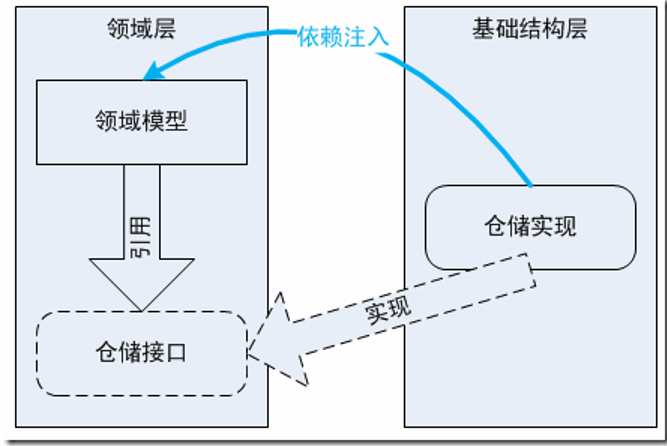DDD领域模型企业级系统Unity(五)
添加程序集:

写一个接口:
public interface IPlayer
{
void Play();
}
两个实现类:
public class NewPlay : IPlayer
{
public void Play()
{
MessageBox.Show("NewPlay");
}
} public void Play()
{ MessageBox.Show("OldPlay");
}
ServiceLocator类:
public class ServiceLocator
{
IUnityContainer container = new UnityContainer();
public ServiceLocator()
{
container.RegisterType<IPlayer, NewPlay>("new");
container.RegisterType<IPlayer, OldPlay>("old");
} public IUnityContainer GetContainer()
{
return container;
}
}
调用:获取一个和全部
ServiceLocator servicelocator =
new ServiceLocator();
var iplay = servicelocator.GetContainer().Resolve<IPlayer>("new");
var iplays = servicelocator.GetContainer().ResolveAll<IPlayer>();
foreach(var iplay in iplays)
{
iplay.Play();
}
构造函数的调用:
[InjectionConstructor]
public OldPlay()
{
MessageBox.Show("构造函数被执行");
}
var iplay = servicelocator.GetContainer().Resolve<IPlayer>("old");
属性注入:
写一个类:
public class Person
{
public string Name { get { return "孙"; } }
public int Age { get { return 32; } }
}
[Dependency]
public Person person { get; set; }
自动实例化
public void Play()
{
MessageBox.Show("OldPlay "+person.Name);
}
方法调用注入:
public Person person { get; set; }
public void Play()
{
MessageBox.Show("OldPlay");
}
[InjectionMethod]
public void Auto(Person person)
{
MessageBox.Show("注入方法 "+person.Name);
}
依赖注入的原理:

添加ProductRepository的仓储:(给聚合根建立仓储)
public class ProductRepository:EFRepository<Product>
{ }
添加SalesOrderRepository的仓储:
public class SalesOrderRepository:EFRepository<SalesOrder>
{
}
添加ProductRepository的仓储:
public class ProductRepository:EFRepository<Product>
{ }
添加CustomerRepository的仓储:
public class CustomerRepository:EFRepository<Customer>
{
}
定义一个实现Product领域逻辑的部分类(继承聚合根):
public partial class Product:AggreateRoot
{
//定义仓储的接口
private IRepository<Product> irepository;
//由调用方指定具体仓储的实现
public Product(IRepository<Product> irepository)
{
this.irepository = irepository;
}
//默认构造函数
public Product()
{ } /// <summary>
/// 实现自身聚合根的职责
/// </summary>
/// <param name="name"></param>
/// <param name="color"></param>
/// <param name="size"></param>
/// <param name="count"></param>
/// <param name="unitprice"></param>
/// <param name="categoryname"></param>
/// <param name="description"></param>
public void CreateProduct(string name,string color,string size,int count,
decimal unitprice,string categoryname,string description)
{
var product = new Product();
product.Id = base.Id; //聚合根的ID
product.ProductName = name;
product.Color = color;
product.Size = size;
product.Count = count;
product.UnitPrice = unitprice;
//聚合根下面的实体和值对象
var productcategory = new ProductCategory(categoryname,description);
product.ProductCategory = productcategory;
//添加到仓储中把对象维护起来
irepository.Create(product); }
/// <summary>
/// 减少库存的责
/// </summary>
/// <param name="p"></param>
/// <param name="amount"></param>
/// <param name="irepository"></param>
public void ModifyCount(Product p,int amount,IRepository<Product> irepository)
{
p.Count = this.Count - amount;
irepository.Update(p);
} public Product GetProducyByName(string productname)
{
return irepository.GetByCondition(p => p.ProductName == productname)
.FirstOrDefault();
}
}
定义一个值对象:(负责维护自己的领域逻辑和状态信息)
public abstract class ValueObject : IValueObject
{
public Guid Id
{
get
{
var id = Guid.NewGuid();
return id;
}
}
} public interface IValueObject
{
Guid Id { get; }
}
产品类别的逻辑:
public partial class ProductCategory:ValueObject
{
public ProductCategory(string categoryname,string description)
{
this.Id = base.Id;
this.CategoryName = categoryname;
this.Description = description;
}
}
地址的值对象:
/// <summary>
/// 值对象
/// </summary>
public partial class Address:ValueObject
{
public Address(string state,string city,string street)
{
this.State = state;
this.City = city;
this.Street = street;
}
}
定义一个实现Customer领域逻辑的部分类(继承聚合根):
public partial class Customer:AggreateRoot
{
//定义仓储接口
private IRepository<Customer> irepository;
//构造函数
public Customer(IRepository<Customer> irepository)
{
this.irepository = irepository;
} public void CreateCustomer(string name,string mobile,string state,string city,
string street)
{
Customer customer = new Customer();
customer.Id = base.Id;
customer.Name = name;
customer.Mobile = mobile;
addcustomeraddress(customer, state, city, street);
irepository.Create(customer);
} /// <summary>
/// 添加地址
/// </summary>
/// <param name="customer"></param>
/// <param name="state"></param>
/// <param name="city"></param>
/// <param name="street"></param>
private void addcustomeraddress(Customer customer,string state,string city,string street)
{
//值对象
var address = new Address(state, city, street);
//添加地址
customer.Address.Add(address);
} public void AddCustomerOtherAddress(Customer customer,string state,string city,
string street)
{
addcustomeraddress(customer, state, city, street);
irepository.Update(customer);
} public Customer GetCustomerByName(string name)
{
return irepository.GetByCondition(p => p.Name == name).FirstOrDefault();
}
}
单元测试(添加引用):

单元测试:
EFRepositoryContext context =
new EFRepositoryContext();
[TestMethod]
public void CreateProduct()
{
//Product product = new Product(new ProductRepository());
ProductAppService product = new ProductAppService();
product.CreateProduct("P1", "Red", "Small", 100, 55, "C1", "T恤类产品");
product.CreateProduct("P2", "Green", "Big", 200, 40, "C2", "运动类产品");
context.Commit();
Assert.IsNotNull(product.GetProductByName("P1")); } [TestMethod]
public void CreateCustomer()
{
Customer customer = new Customer(new CustomerRepository());
customer.CreateCustomer("sun", "13458629365", "sanxi", "sanxi", "sanxi");
context.Commit();
Assert.IsNotNull(customer.GetCustomerByName("sun"));
}
DDD领域模型企业级系统Unity(五)的更多相关文章
- DDD领域模型企业级系统(二)
用户层: 1.请求应用层获取用户显示的信息 2.发送命令给应用层要求执行某个命令 应用层: 对用户界面提供各种应用功能(包括信息获取与命令执行),应用层不包含业务逻辑,业务层是由应用层调用领域层(领域 ...
- DDD领域模型企业级系统(一)
领域模型的基本构造块: 1.实体(Entity):有业务生命周期,使用标识进行跟踪. 2.值对象(Value Object):无业务生命周期,用来描述实体. 3.服务(Service):无状态的行为类 ...
- DDD领域模型企业级系统Linq的CRUD(四)
建造一个Product Module类: ProductDBContextDataContext dbcontext = new ProductDBContextDataContext(); publ ...
- DDD领域模型企业级系统(三)
相关代码: public static void ShowArray() { //数据源 int[] arrayas = new int[] { 1, 2, 3, 4 }; //创建查询 var qu ...
- DDD领域模型和充血对象
DDD领域模型 官方说法 领域驱动设计,它是对面向对象的的分析和设计(OOAD,Object Orient Analysis Design)的一个补充,对技术框架进行了分层规划,同时对每个类进行了策略 ...
- Android系统的五种数据存储形式(一)
Android系统有五种数据存储形式,分别是文件存储.SP存储.数据库存储.contentprovider 内容提供者.网络存储.其中,前四个是本地存储.存储的类型包括简单文本.窗口状态存储.音频视频 ...
- 【百度地图API】建立全国银行位置查询系统(五)——如何更改百度地图的信息窗口内容?
原文:[百度地图API]建立全国银行位置查询系统(五)--如何更改百度地图的信息窗口内容? 摘要: 酷讯.搜房.去哪儿网等大型房产.旅游酒店网站,用的是百度的数据库,却显示了自定义的信息窗口内容,这是 ...
- Android系统--输入系统(五)输入系统框架
Android系统--输入系统(五)输入系统框架 1. Android设备使用场景: 假设一个Android平板,APP功能.系统功能(开机关机.调节音量).外接设备功能(键盘.触摸屏.USB外接键盘 ...
- DDD领域模型实现依赖注入(六)
添加下订单的值对象: public partial class CustomerInfo:ValueObject { /// <summary> /// 下订单的值对象 /// </ ...
随机推荐
- TCP 协议连接与关闭的握手
原文链接 http://blog.csdn.net/oney139/article/details/8103223 TCP头部: 其中 ACK SYN 序号 这三个部分在以下会用到,它们 ...
- 【大数据】Scala学习笔记
第 1 章 scala的概述1 1.1 学习sdala的原因 1 1.2 Scala语言诞生小故事 1 1.3 Scala 和 Java 以及 jvm 的关系分析图 2 1.4 Scala语言的特点 ...
- (转)JDK1.8新特性Lambda表达式
https://www.cnblogs.com/franson-2016/p/5593080.html Predicate predicate接收一个变量,并返回一个boolean值,predicat ...
- Number Clicker CodeForces - 995E(双向bfs)
双向bfs 注意数很大 用map来存 然后各种难受....
- oracle 查出一个表中字段值出现次数大于2的所有记录
表web_order 列 name ,businesscode, a.account 周桥 18929609222 3754031157710000妙药 18929609233 3754031157 ...
- MT【75】考察高斯函数的一道高考压轴题
解答:答案1,3,4. 这里关于高斯函数$[x]$的一个不等式是需要知道的$x-1<[x]\le x$,具体的:
- 【刷题】BZOJ 1823 [JSOI2010]满汉全席
Description 满汉全席是中国最丰盛的宴客菜肴,有许多种不同的材料透过满族或是汉族的料理方式,呈现在數量繁多的菜色之中.由于菜色众多而繁杂,只有极少數博学多闻技艺高超的厨师能够做出满汉全席,而 ...
- 【BZOJ1028】[JSOI2007]麻将(贪心)
[BZOJ1028][JSOI2007]麻将(贪心) 题面 BZOJ 洛谷 题解 感觉好久没打过麻将了,似乎都快不会打了. 这个数据范围看着就觉得是\(O(n^2m)\). 那么就枚举听哪张牌,然后枚 ...
- 洛谷 P2607 [ZJOI2008]骑士 解题报告
P2607 [ZJOI2008]骑士 题目描述 Z国的骑士团是一个很有势力的组织,帮会中汇聚了来自各地的精英.他们劫富济贫,惩恶扬善,受到社会各界的赞扬. 最近发生了一件可怕的事情,邪恶的Y国发动了一 ...
- Python序列化与反序列化-json与pickle
Python序列化与反序列化-json与pickle 作者:尹正杰 版权声明:原创作品,谢绝转载!否则将追究法律责任. 一.json的序列化方式与反序列化方式 1>.json序列化 #!/usr ...
